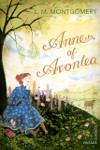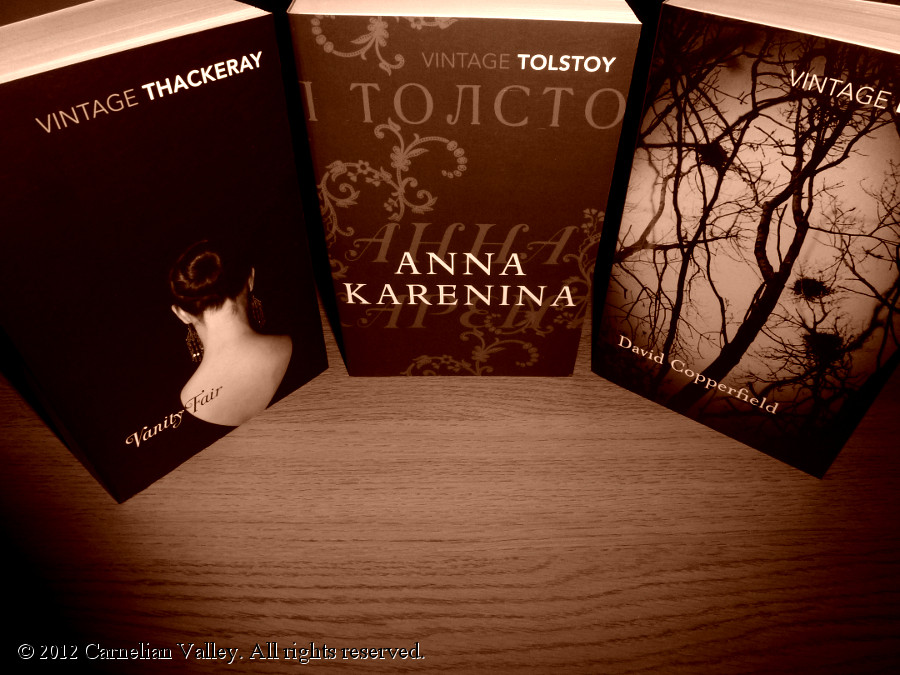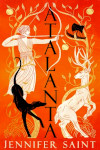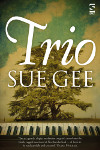February 2019 Reading Round Up
Posted 1st March 2019
Category: Round-Ups Genres: N/A
3 Comments
Linen trousers and a t-shirt outside in British late February when the earliest opportunity had previously been mid-March… it has been lovely but also very worrying. I digress.
My literary February was all about classics. Looking at my shelves after each finished final page I attempted a contemporary novel, but nothing worked. Polly Clark’s Larchfield had to go back to its space, only a few pages read, and even the last Sherry Thomas book I have waiting for me, in all its easy-reading goodness, didn’t get my attention. Instead I found comfort in the mid-1800s; I thought it might be time to explore the world of the youngest Brontë writer and that proved correct, and later L M Montgomery’s famous series – written in the early 1900s but set in the 1860s and onward – drew me. I’ve often thought I might like to read the Anne novels, yet reckoned it might stay an idea unfulfilled – I think that would’ve been fine in regards to the first book, but the second is not to be missed.
All books are works of fiction.
The Books

Anne Brontë: Agnes Grey – In order to help her family, a young woman becomes a governess, but finds a lot of problems in the world of the wealthy that she did not expect. The plot isn’t particularly thrilling but it’s well-written, an easy read, full of memorable paragraphs, and sports a nice romantic thread.

L M Montgomery: Anne Of Green Gables – The Cuthbert siblings arrange for an orphan boy to be sent to them to help on the land, but when they receive a girl instead, they decide to keep her despite her inability to stop talking and her penchant for daydreaming. It doesn’t really go anywhere, prefers to work in cycles of events, but it’s an easy, fair, read.

L M Montgomery: Anne Of Avonlea – Details the years following Anne’s childhood as she steps into her role as a teacher. A much better book: it’s got the same atmosphere of the first, but the plot here is more thought-out and interesting.

Monica Ali: Brick Lane – When Nazneen was married to Chanu, he took her from Bangladesh to Britain with the promise of a better life, but they continue to reside in the flat the council gave them and Nazneen wants a little more from life. There needed to be a lot more to this book – everything in it has been done before and it’s quite frustrating when it starts to look like it’s going somewhere only for Ali to drop the subject soon after she’s begun (this happens a number of times).
The second Anne book pipped Brontë to the post at the eleventh hour; I loved the grown-up Anne and Montgomery seems to have got into her stride in regards to creating fun characters.
Quotation Report
In Anne Of Avonlea a woman, so fastidious about her house, lays newspaper down not only on her floors but all the way down the garden path, and requests her visitors to wipe their feet before treading on it. And, unrelated to this, a little boy wonders why male angels can’t wear trousers; he’s the very same boy who later pulls up his plants by the roots to see how they are getting on at the other end. Unsurprisingly, his twin sister’s garden is more successful.
The plan for March is to read at least one more classic and get to a review copy that I was sent in January that is published in April – Sofie Laguna’s The Choke. I also have an Elizabeth Chadwick on the go which I’d like to make more of a priority, and I will most likely keep reading Montgomery: I’d like to read the next Anne book, and having started the series I’m very tempted to return to The Blue Castle.
I have been away – update me on your reading!
January 2019 Reading Round Up
Posted 1st February 2019
Category: Round-Ups Genres: N/A
3 Comments
For the most part, January was a very busy month – Christmas clean up, improvements; I kept going with the books I was already reading and, knowing I’d likely not finish those by February, added easy novels for a sense of achievement. I’m reading quite a bit for discussion posts – it’s a lot of pages in total, just no entire books to speak of.
All books are works of fiction.
The Books

Eloisa James: When Beauty Tamed The Beast – Having unintentionally caused high society to think she’s pregnant, unmarried Linnet is sent to the home of a notoriously difficult doctor who cannot give his father a grandchild. Strictly okay – works best if viewed wholly in the context of its inspiration, both the original story and the use of Hugh Laurie’s Doctor House.

Eloisa James: The Duke Is Mine – Betrothed to her father’s friend’s son since birth, Olivia accompanies her twin sister to the house of the Duke of Sconce in order to aid their pairing, but finds herself drawn to the Duke herself. This is loosely based on The Princess And The Pea; it’s alright, but has a similar problem as the previous book in terms of hero.

Gail Honeyman: Eleanor Oliphant Is Completely Fine – Lacking social skills, Eleanor lives on the fringes of life, getting through the week by going to work, watching television, and drinking a lot; over the course of the book we see how her life has been shaped by a traumatic childhood and a lack of support going forward. An utterly fantastic book.
In Honeyman’s novel, I believe I’ve found one of my ‘best of 2019’ books already. I wasn’t personally keen on the way the weekly phone calls were resolved, but everything other than that I loved, and objectively the resolution does work well.
For February, other than a vague plan to read the Kelby I listed previously, I’m staying away from lists. I’ve found I’m doing that ‘all the books’ thing where getting excited about what you can read means you don’t actually start; the less books I have in mind, the more I might read.
What has been your favourite book so far this year?
Musings On The Importance Of Contexts When Forming An Opinion Of Characters
Posted 28th January 2019
Category: Chit-Chat Genres: N/A
1 Comment

In trying to write about a particular character, I reached a point where I couldn’t continue without considering the author’s reason for including that character. This of course led me to consider the oft-debated topic of whether we should view a text in the context of its writer. And due to the fact that what I’d been working on had been inspired by a discussion about a character from not only a different book but different type of book, I’d also recognised the difficulties in applying any sort of template to a character study.
Of backgrounds, if we use my inspiration (Leo Tolstoy’s Anna Karenina) and the character I wanted to write about (Diana Gabaldon’s Claire Fraser/Randall), it’s immediately obvious; you can’t apply or, generally, so much as consider, the characters from a similar perspective without soon finding yourself in a bit of a quandary. Anna Karenina is – spoilers incoming – a way for Tolstoy to discuss the different ways society treated infidelity depending on gender – and Claire Fraser is the way in which Gabaldon explores the idea of romance in the context of time travel. It would be difficult to compare the two characters – there’s little reason to – and likewise, it’s difficult to apply the same modes of thinking to a character study for each, beyond insignificant (to their stories) details. How they takes their tea? Perhaps.
Context of all kinds allows us to give reason for motivations and thinking, and the author context is a part of that. Both need establishing for the rest to work.
In terms of my plans, they’ll require a bit more research.
Who is one of your favourite characters in terms of their role in the book?
Analyses Of First Lines #6
Posted 23rd January 2019
Category: Close Reading Genres: N/A
4 Comments
January has brought with it an interesting mix of older and new books. One such book is brand new – I received Sofie Laguna’s The Choke a few days ago, to some surprise. Together with the feeling of freshness, the new year has brought with it a renewed enthusiasm for new releases, and while I’m not going to make any promises in regards to this particular book, I will likely read and review it.
There is one book absent from this list that really should be on it as it’s a current read, but the line was dull and I’ve written enough about Eloisa James’ novels recently. It did however bring up an interesting question – when there are sentences before the narrative, such as those that set the scene, when or where exactly does a book begin?
Eleanor Oliphant Is Completely Fine by Gail Honeyman
When people ask me what I do – taxi drivers, dental hygienists – I tell them I work in an office.

Like the entirety of the book, if I may be so bold as to bring my general opinion into this post, Honeyman’s first line is a feat of writing, providing not only background detail but personality, mood, and a sense of what will follow. Starting her book with a question put to the narrator by ‘people’, which the content within the dashes shows includes familiars and complete strangers, points to a likelihood of the narrator having a passive role in either his/her life or society in general. The use of ‘taxi drivers, dental hygienists’ implies that the narrator doesn’t have people close to them – we often use ‘people’, but rarely spell out who ‘people’ includes.
And so, with these named categories of people, we can assume that there may be a gap somewhere between this person and society – perhaps they don’t get on with others, or perhaps they’re very introverted. In this vein, the choice of categories is interesting, suggesting the person goes to medical appointments and perhaps nowhere else or very few other places; the taxi takes them to the dentist. They likely do not drive.
Why ‘an office’? Is the job too complex and the narrator became bored with trying to explain it? Are they embarrassed by their job? Or do they perhaps just not want to tell anyone or make conversation?
Elmet by Fiona Mozley
I cast no shadow.

The character may be a ghost, or perhaps a person who is rarely or never noticed; the sort of opinion given here in first-person echoes a child’s feelings – perhaps their family is dysfunctional. Other options include fantasy-type characters, thieves, or animals.
Looking past the pronoun, we see a situation of either promise of worry. While ‘cast’ can be past tense, it’s quite likely we’re looking at a situation happening at present – someone hiding from something or someone for a reason not yet revealed to us. It’s not the most informative of lines, but it sets the scene well enough.
The Choke by Sofie Laguna
Kirk turned his slingshot over in his hand.

Continuing on the theme of likely young narrators, Laguna’s first line called to my mind To Kill A Mockingbird – there may not be a slingshot in the opening pages of Lee’s tale, but Laguna’s set up of a child about to be hurt, struck me as similar. Unlike Jem and his sport-related injury, however, here we have either a mischievous child or, more likely given the weapon, the beginnings of a scene of bullying. A bully who is taking his time, either simply drawing it out or about to start some cruel talk. It’s not going to be an easy page to read.
Brick Lane by Monica Ali
An hour and forty-five minutes before Nazneen’s life began – began as it would proceed for quite some time, that is to say uncertainly – her mother Rupban felt an iron fist squeeze her belly.

This first line sports names that give you an idea as to the possible locations for this book, however, prior to it, the location and date are included under the chapter heading, so we already know we’re in Pakistan, 1967. What the line does provide is a bit of the family culture we’re likely dealing with. Ali’s use of em dashes and the content between them, suggests that Nazneen may be on the ‘hook’ for something for a fair length of her childhood. (We already know Rupban’s labour was an hour and forty five minutes.) We’re looking at the prospect of some of the story dealing with elements of Nazneen’s future life that stem from her birth – perhaps a running joke or constantly retold anecdote she has to hear.
There’s another possible story element hinted at: Nazneen’s strength. The use of ‘iron fist’ could suggest strength of character.
White Truffles In Winter by N M Kelby
That last summer, the kitchen reeked of pickling spice, aniseed and juniper berries.

Three foods, if we lump ‘spices’ into one for a moment and consider aniseed and juniper in their own right. Just what you want from a book that has food in its title. The use of ‘summer’ here, contrasted with the Winter of the title, suggests that winter may bring with it a big change. And the use of past tense and ‘last’, which is likely about a previous season rather than any finality, suggests winter will indeed be in the spotlight.
Whether or not Kelby means us to see the aniseed and juniper as the two ‘spices’ of the sentence, we have some strong smells and tastes here. I looked up the two together to see if Kelby was meaning us to read more into the combination – there’s a slight possibility of Scandinavia (a salmon dish that uses the two spices, amongst others) or alcohol, though the second is more of a guess. Wherever we are, we’re looking at a licorice-smelling kitchen – something quite a lot different to truffles!
Conclusion
As I started to put these first lines into an order I noticed a similarity; whilst the fact that three lines dealt with the likely subject of childhood, they all also had a potential in them regarding the role of the parent. A child who might be invisible; a child who might be bullied but might be experiencing abuse; a child whose parents may see them in a certain way. It’s interesting how comparisons can be drawn between the most unlikely stories; Elmet and The Choke do appear to be similar, at least in regards to what the blurbs say, but Brick Lane is mostly about an immigrant’s experience. I have a want, almost, to write something about all this, but it would be difficult to find the angle.
I note this ‘finding’ because it relates to something else I’m currently working on, a character study inspired by a conversation about another character, the context of each being vastly different and requiring comment. Similarities can come from the most unlikely of subjects, but sometimes it can be interesting to accept the strangeness, consider it, and continue.
Reflections On Outlander Series One, In Context
Posted 16th January 2019
Category: Further Thoughts Genres: N/A
3 Comments

Photograph/screen shot from Outlander, copyright © 2014 Neil Davidson/Sony Pictures TV.
Following up the book with the TV show or film, with less than a day in between, tends to have drawbacks; the screen might not live up to the book, and with everything clear in your mind, it’s very easy to notice changes.
For me, Outlander didn’t follow that trend. I’d read the book when I did because I’d discovered the show on Amazon, and found the adaptation to be incredibly well done. It’s most often faithful to the book, but the times it’s not are handled with aplomb. By episode four, I knew I’d have to write about it, and this was an idea I enjoyed more than the idea of writing about the 1991 publication.
The show is not as long-winded as the book. It couldn’t be, of course. There is less time in which to tell the tale, and the audience – naturally including far more people than the original readers – wouldn’t be as patient, especially nowadays. (It makes a difference that the series arrived over 20 years after the first book was published.) The show is slicker for it. On her website (n.d.), Gabaldon says the series started by accident in the late 1980s when she decided to write a novel for “practice”, and that one of her goals was to learn what it took to write one. She continues:
In essence, these novels are Big, Fat, Historical Fiction, á la James Clavell and James Michener. However, owing to the fact that I wrote the first book for practice, didn’t intend to show it to anyone, and therefore saw no reason to limit myself, they include…
She lists a plethora of plot elements and genres. The statements match the content: lengthy, and sort of introspective and indulgent at times, considering Gabaldon was writing for herself. The show does away with a lot of the length and indulgence1.
Something lacking from the book that can be pinned on the fact that it is about Claire and Jamie’s relationship, is Frank. Claire doesn’t think of him all that much, but having him drop from the narrative completely means the time travel factor is somewhat lost. The show includes a few scenes of Frank looking for Claire. While totally made up for the show and quite possibly not on the timeline Gabaldon envisaged, these few scenes rectify the time travel problem. Frank’s inclusion enables the production crew to take the story further, showing how just the shortest nod to Frank – in his own right, rather than as a memory for Claire to discuss – changes the narrative for the better. It’s likely true we’re not meant to feel much for Frank, but having him off the page seemed a bit too easy.
The show doesn’t tend to specify dates, leaning more on seasons of the year. The book mentions specific days. (Whilst the section in the prison is horrific, I found literary happiness when I read that ‘tomorrow’ was 22nd December, and I was at that moment sat beside my Christmas tree on 21st.) The show simply moves the action at the beginning to a different season. This, whether planned with it in mind or not, neatly gets around the problem in the book wherein the days of Christmas come and go, at a monastery no less, without a mention. Christmas in the show is moved forward, and though not actively celebrated (likely a diversion too far) the rooms at Castle Leoch are decorated. The winter season is introduced with its own camera shot, snow falling in the Highlands.
I was impressed by the handling of the sex scenes, balanced between fidelity to the source and what would work on television; no less explicit but fewer in number; a couple of fade to blacks. Of that scene where Jamie punishes Claire and then may or may not have coerced her into sex depending on your interpretation, it seemed the crew had taken reader comments and criticisms on board, both those related to the action itself and those who were discussing the historical context. The historical context had been very brief in the book. After the initial argument between the couple, which was well done, I was actually surprised the next part of the story was included; the acting by Sam Heughan brought a lot more of the historical context into it, and the scene was scripted and filmed so that it goes straight to the fact of the matter and is careful in its visuals.
It’s great to hear from Jamie’s perspective; though only used in the ninth episode, The Reckoning, it was good to get out of Claire’s head and be able to see Jamie for himself. A reason for the change may well have been so that the crew could develop better a storyline Claire only heard about, but whatever the reason, it produced better content and a more rounded, historical, narrative. It also allowed for more historical and character context in the scene of resolution, post punishment.
Changes/elements I don’t think worked so well in general included the ending, which shortens a section considerably and changes the location of the monastery so that the sailing to France is the cliff hanger of series one rather than the conclusion of the section in Wentworth Prison. However, context matters here: it works as a ‘teaser’ for series two, it’s simply that the book ends in a way that’s both a minor cliff hanger and a fully-fledged ending.
As series one continues, the crew take more liberties. The Watch was unnecessary, an extra few characters for not much gain. But whilst lengthy, I liked Claire’s dinner with the British officers and her following dealings with Randall. It gave a fuller picture of him and succeeded in being suspenseful in its own right.
Where fidelity to the source is concerned and, I’d argue, good planning when changes are made, Outlander has to be one of the best adaptations I’ve seen. The acting is excellent, and the boldness in choosing what to keep, and, at times, what to expand upon when it comes to the explicit, is striking.
Footnotes
1 It’s interesting to note Gabaldon’s role in all this. The author is heavily involved in the production; credited as Consultant, she reviews all the scripts and watches the first cuts, checking for historical accuracy and anything that’s been changed from the book that could conflict with the storyline later on (Napoli, 2018). One such change for accuracy involved the scene wherein Claire joins a group of village women to dye wool; a fictional addition in terms of the book, the production crew had written a scene in which Claire walked down a cobbled street and joined a woman for tea and Bridge – Gabaldon scrapped the idea as it wasn’t representative of the era, describing instead a workaround which became the wool scene (Gabaldon, 2016).
About the differences in medium, the author said (ibid.):
I also know the constraints they were dealing with, which is that they have a limited number of 55-minute blocks, and within that block, you have to have a little dramatic arc.
Online References
Gabaldon, Diana (n.d.) The Outlander Series, Diana Gabaldon’s website, accessed 10th January 2019
Gabaldon, Diana (2015) Interview: Diana Gabaldon on Sam Heughan – ‘I was sitting there typing, “this man is grotesque, what are you thinking?”‘, The List, accessed 11th January 2019
Gabaldon, Diana (2016) ‘Outlander’: How author Diana Gabaldon really feels about Sam Heughan and Caitriona Balfe, Entertainment Weekly, accessed 11th January 2019
Gabaldon, Diana (2018) So… four years!, Diana Gabaldon’s Facebook page, accessed 16th January 2019
Napoli, Jessica (2018) ‘Outlander’: Author Diana Gabaldon reveals which line Sam Heughan didn’t want to say and more, TV Insider, accessed 11th January 2019






















